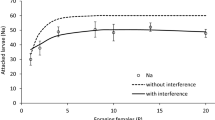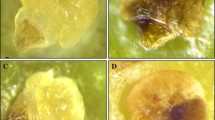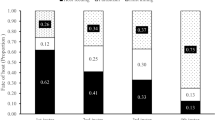Abstract
Hyperparasitism by virgin female Encarsia tricolor was studied by direct observation of its behaviour when contacting two secondary host species (Encarsia formosa and E. tricolor) at different host stages (first and second larval stage, third larval stage, and pupal stage). The searching and hyperparasitism behavioural sequence of E. tricolor was independent of the host stage of the whitefly (Aleyrodes proletella), and was similar to several related primary parasitoid species. In experiments with equal numbers of secondary hosts, encounter frequencies were equal for both secondary host species in all developmental stages observed. However, rates of hyperparastism were different according to host stage and host species. Hosts in the late larval stages were most preferred for hyperparasitization and the heterospecific E. formosa was more preferred as a secondary host than the conspecific, E. tricolor, in particular from the prepupal stage onwards. The window of vulnerability, i.e., the duration of the period in which a secondary host is susceptible to hyperparasitism, was largely determined by the occurrence and rate of melanization after the onset of pupation. The duration of a successful hyperparasitization event was longer than one that failed. Superparasitism occurred only once in all cases. The potential effect of autoparasitoids on biological control programs and the consequences for selection and release of an effective, yet ecologically safe agent are discussed.





Similar content being viewed by others
References
Avilla J, Copland MJW (1987) Effects of host stage on the development of the facultative autoparasitoid Encarsia tricolor (Hymenoptera: Aphelinidae). Ann Appl Biol 110:381–389
Avilla J, Anadón J, Sarasúa MJ, Albajes R (1991) Egg allocation of the autoparasitoid Encarsia tricolor at different relative densities of the primary host (Trialeurodes vaporariorum) and two secondary hosts (Encarsia formosa and E. tricolor). Ent Exp Appl 59:219–227
Bográn CE, Heinz KM (2002) Host selection by the heteronomous hyperparasitoid Encarsia pergandiella: multiple-choice tests using Bemisia argentifolii as primary host. Ent Exp Appl 103:11–21
Bográn CE, Heinz KM, Ciomperlik M (2002) Interspecific competition among insect parasitoids: field experiments with whiteflies as hosts in cotton. Ecology 83:653–668
Briggs CJ, Collier TR (2001) Autoparasitism, interference, and parasitoid-pest population dynamics. Theor Popul Biol 60:33–57
Buijs MJ, Pirovano I, van Lenteren JC (1981) Encarsia pergandiella, a possible biological control agent for the greenhouse whitefly, Trialeurodes vaporariorum: A study on intra- and interspecific host selection. Med Fac Landbouww RU Gent 46(2):465–471
Burger JMS, Huang Y, Hemerik L, van Lenteren JC, Vet LEM (2006) Flexible use of patch-leaving mechanisms in a parasitoid wasp. J Insect Behav 19:155–170
Del Bene G, Landi S (1991) Biological pest control in glasshouse ornamental crops in Tuscany. Bull IOBC/WPRS 14(5):13–21
Gabarra R, Arnó J, Alomar O (1999) Naturally occurring populations of Encarsia pergandiella (Hymenoptera: Aphelinidae) in tomato greenhouses. Bull OILB/WPRS 22:85–88
Gabarra R, Batllori M, Albajes R (2003) Encarsia formosa and Encarsia pergandiella: addition or substraction. Bull IOBC/WPRS 26(10):33–38
Gerling D (1990) Whiteflies: their bionomics pest status and management. Intercept, Andover, UK
Gerling D (1966) Studies with whitefly parasites of Southern California. I. Encarsia pergandiella Howard (Hymenoptera: Aphelinidae). Can Entomol 98:707–724
Gerling D, Alomar O, Arnó J (2001) Biological control of Bemisia using predators and parasitoids. Crop Prot 20:779–799
Giorgini M, Viggiani G (2000) A compared evaluation of Encarsia formosa Gahan and Encarsia pergandiella Howard (Hymenoptera: Aphelinidae) as biological control agents of Trialeurodes vaporariorum (Westwood) (Homoptera: Aleyrodidae) on tomato under greenhouse in south Italy. Bull IOBC/WPRS 23(1):109–116
Gurr G, Wratten S (eds) (2000) Measures of success in biological control. Kluwer, Dordrecht, The Netherlands 448 pp
Hassell MP (2000) The spatial and temporal effect of host-parasitoid interactions. Oxford, UK
Heimpel GE, Collier TR (1996) The evolution of host-feeding behaviour in insect parasitoids. Biol Rev 71:373–400
Heinz KM, Nelson JM (1996) Interspecific interactions among natural enemies of Bemisia in an inundative biological control program. Biol Control 6:384–393
Howarth FG (1991) Environmental impacts of classical biological control. Annu Rev Entomol 36:485–509
Huang Y, Loomans A, Bukovinszkiné-Kiss G, van Lenteren JC (2002) Heteronomous hyperparasitoids for biological control of whiteflies: for better or for worse? Exp Appl Entomol N.E.S 13:131–136
Hunter MS (1989) Sex allocation and egg distribution of an autoparasitoid, Encarsia pergandiella (Hymenoptera: Aphelinidae). Ecol Entomol 14:57–67
Hunter MS, Kelly SE (1998) Hyperparasitism by an exotic autoparasitoid: secondary host selection and the window of vulnerability of conspecific and native heterospecific hosts. Ent Exp Appl 89:249–259
Hunter MS, Woolley JB (2001) Evolution and behavioral ecology of heteronomous aphelinid parasitoids. Annu Rev Entomol 46:251–290
Hunter M, Kelly S, Collier T (2002) Does an autoparasitoid disrupt host suppression provided by a primary parasitoid? Ecology 83:1459–1469
Jervis MA, Kidd NAC (1986) Host-feeding strategies in hymenopteran parasitoids. Biol Rev 61:395–434
Jones WA, Greenberg SM (1999) Host instar suitability of Bemisia argentifolii (Homoptera: Aleyrodidae) for the parasitoid Encarsia pergandiella (Hymenoptera: Aphelinidae). J Agric Urban Entomol 16:49–57
Kajita H (1989) Mating and oviposition of three Encarsia species (Hymenoptera: Aphelinidae) on the greenhouse whitefly Trialeurodes vaporariorum (Westwood) (Homoptera: Aleyrodidae). Appl Entomol Zool 24:11–19
Kajita H (2000) Geographical distribution and species composition of parasitoids (Hymenoptera: Chalcidoidea) of Trialeurodes vaporariorum and Bemisia tabaci-complex (Homoptera: Aleyrodidae) in Japan. Appl Entomol Zool 35:155–162
Liu T-X, Stansly PA (1996) Pupal orientation and emergence of some aphelinid parasitoids (Hymenoptera) of Bemisia argentifolii (Homoptera: Aleyrodidae). Ann Entomol Soc Am 89:385–390
Loomans AJM, van Lenteren JC (1999) Evaluating environmental effects of Encarsia species (Hymenoptera: Aphelinidae) introduced for whitefly control into Europe. Bull IOBC/WPRS 22(1):153–156
Louda SM, Pemberton RW, Johnson MT, Follett PA (2003) Non-target effects: the Achilles’ heel of biological control? Retrospective analyses to reduce risk associated with biocontrol introductions. Annu Rev Entomol 48:365–396
Luck RF, Messenger PS, Barbieri JF (1981) The influence of hyperparasitism on the performance of biological control agents. In: Rosen D (ed) The role of hyperparasitism in biological control: a symposium. Agricultural Sciences Publications, Berkeley, California, USA, pp 34–43
Manzano MR, van Lenteren JC, Cardona C (2002) Searching and oviposition behaviour of Amitus fuscipennis, a parasitoid of the greenhouse whitefly. J Appl Entomol 126:528–533
May RM, Hassell MP (1981) The dynamics of multiparasitoid-host interactions. Am Nat 117:234–261
Mills NJ, Gutierrez AP (1996) Prospective modelling in biological control: an analysis of the dynamics of heteronomous hyperparasitism in a cotton-whitefly-parasitoid system. J Appl Ecol 33:1379–1394
Minkenberg OPJM, Tatar M, Rosenheim JA (1992) Egg load as a major source of variability in insect foraging and oviposition behavior. Oikos 65:135–142
Murdoch WM (1996) Theory for biological control: recent developments. Ecology 77:2001–2013
Nuffio CR, Papaj DR (2001) Host marking behavior in phytophagous insects and parasitoids. Ent Exp Appl 99:273–293
Pedata PA, Hunter MS (1996) Secondary host choice by the autoparasitoid Encarsia pergandiella. Ent Exp Appl 81:207–214
Pedata PA, Giorgini M, Guerrieri E (2002) Interspecific host discrimination and within-host competition between Encarsia formosa and E. pergandiella (Hymenoptera: Aphelinidae), two endoparasitoids of whiteflies (Hemiptera: Aleyrodidae). Bull Ent Res 92:521–528
Rosen D (1981) The role of hyperparasitism in biological control: a symposium. Agricultural Sciences Publications, Berkeley, California, USA
Schreiber SJ, Mills NJ, Gutierrez AP (2001) Host-limited dynamics of autoparasitoids. J Theor Biol 212:141–153
Sengonça C, Wang X-Q, Liu B (2001) Development, longevity and parasitization of white fly parasitoid, Encarsia tricolor Forster (Hym., Aphelinidae), at different temperatures. Z Pflkrankh Pflsch 108:298–304
Sullivan DJ, Völkl (1999) Hyperparasitism: multitrophic ecology and behavior. Annu Rev Entomol 44:291–315
van Lenteren JC (1981) Host discrimination by parasitoids. In: Nordlund DA, Jones RL, Lewis WJ (eds) Semiochemicals: their role in pest control. Wiley, New York, pp 153–179
van Lenteren JC, Woets J (1988) Biological control and integrated pest control in greenhouses. Annu Rev Entomol 33:239–269
van Lenteren JC, Nell HW, Sevenster-van der Lelie LA, Woets J (1976a) The parasite-host relationship between Encarsia formosa (Hymenoptera: Aphelinidae) and Trialeurodes vaporariorum (Homoptera: Aleyrodidae), I: host finding by the parasite. Ent Exp Appl 20:123–130
van Lenteren JC, Nell HW, Sevenster-van der Lelie LA (1976b) The parasite-host relationship between Encarsia formosa (Hymenoptera: Aphelinidae) and Trialeurodes vaporariorum (Homoptera: Aleyrodidae), III: Discrimination between parasitized and unparasitized hosts by the parasite. Z Ang Entomol 81:377–380
van Lenteren JC, Nell HW, Sevenster-van der Lelie LA (1980) The parasite-host relationship between Encarsia formosa (Hymenoptera: Aphelinidae) and Trialeurodes vaporariorum (Homoptera: Aleyrodidae), IV: Oviposition behaviour of the parasite, with aspects of host selection, host discrimination and host feeding. Z Ang Entomol 89:442–454
van Lenteren JC, van Roermund HJW, Sütterlin S (1996) Biological control of greenhouse whitefly (Trialeurodes vaporariorum) with the parasitoid Encarsia formosa: how does it work? Biol Control 6:1–10
van Lenteren JC, Bale J, Bigler F, Hokkanenand HMT, Loomans AJM (2006) Assessing the risks of biological control agents of arthropod pests. Annu Rev Entomol 51:609–634
van Roermund HJW, van Lenteren JC, Rabbinge R (1996) Biological control of greenhouse whitefly with the parasitoid Encarsia formosa on tomato: an individual-based simulation approach. Biol Control 9:25–47
Williams JR (1977) Some features of sex-linked hyperparasitism in Aphelinidae (Hymenoptera). Entomophaga 22:345–350
Williams T (1991) Host selection and sex ratio in a heteronomous hyperparasitoid. Ecol Entomol 16:377–386
Williams T (1995) The biology of Encarsia tricolor: an autoparasitoid of whitefly. Biol Control 5:209–217
Williams T (1996) Invasion and displacement of experimental populations of a conventional parasitoid by a heteronomous hyperparasitoid. Biocontrol Sci Technol 6:603–618
Acknowledgements
Y. Huang greatly appreciated a study grant from the Royal Dutch Academy of Sciences (KNAW) to accomplish her study at Wageningen University, the Netherlands. John Thompson (Bioforce Ltd, Auckland, NZ) is thanked for his information on E. pergandiella. This study was also supported by the Chinese State Key Basic Research and Development Plan G2000046803 and the Commission of the European Communities, Agriculture and Fisheries (FAIR) specific RTD program CT97–3489, “Evaluating Environmental Risks of Biological Control Introductions into Europe” (ERBIC). Two anonymous reviewers are thanked for their excellent comments.
Author information
Authors and Affiliations
Corresponding author
Additional information
Handling editor: Torsten Meiners.
Rights and permissions
About this article
Cite this article
Huang, Y., Loomans, A.J.M., van Lenteren, J.C. et al. Hyperparasitism behaviour of the autoparasitoid Encarsia tricolor on two secondary host species. BioControl 54, 411–424 (2009). https://doi.org/10.1007/s10526-008-9189-2
Received:
Accepted:
Published:
Issue Date:
DOI: https://doi.org/10.1007/s10526-008-9189-2




